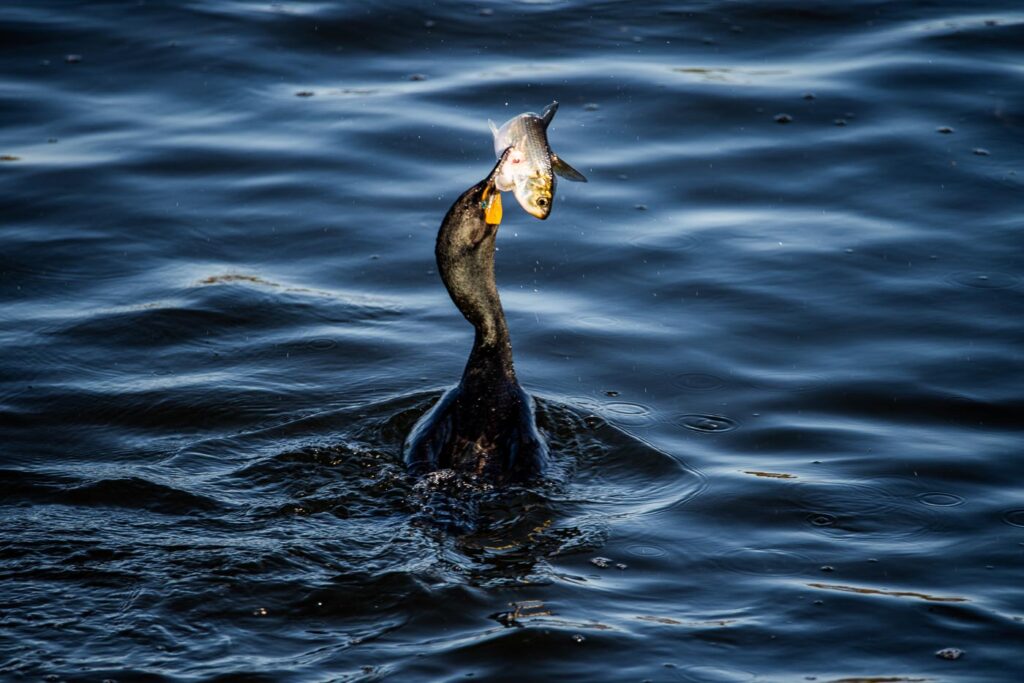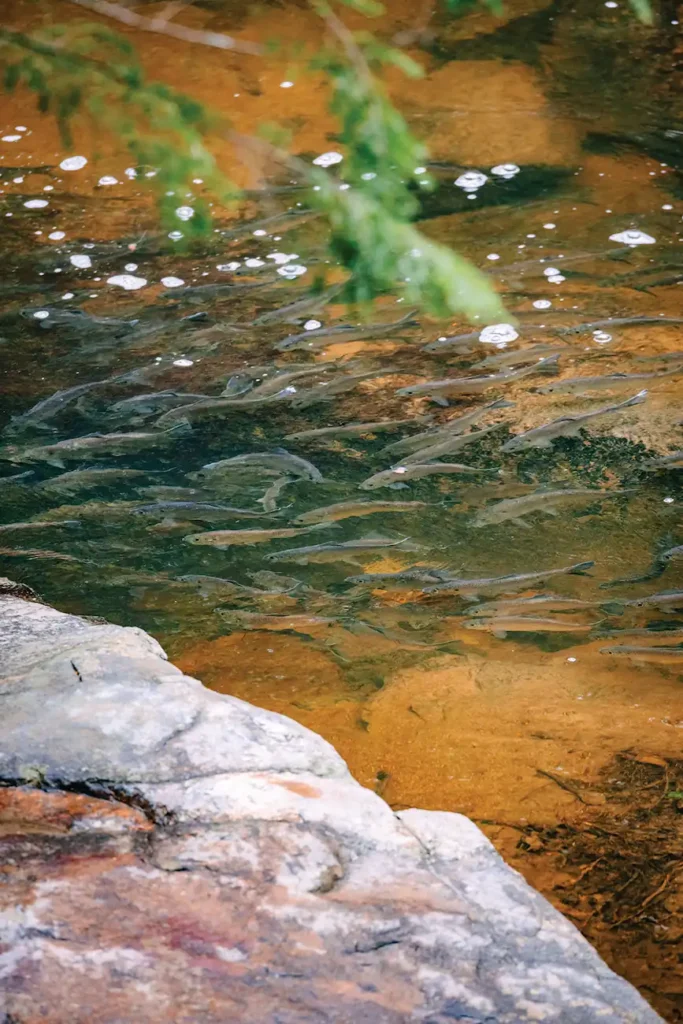By Brian Kevin
Photos by Benjamin Williamson, Michael D. Wilson, Mat Trogner, and Dave Dostie
From our May 2023 issue
Last year was a good one for alewives, the small, silvery, anadromous fish that once migrated up Maine’s streams each spring by the hundreds of millions. For the first time in 50 years, they returned to spawn in all five ponds in the Blue Hill peninsula’s Bagaduce River watershed. In central Maine, they swam up Vassalboro’s Outlet Stream and into China Lake for the first time since 1783. Both recoveries were hard won, the result of years of stakeholders working together to build fish passage around, or to simply remove, the dams and culverts that have, for centuries, blocked sea-run fish from their historical spawning grounds.
Such projects are returning spring alewife runs to more and more Maine rivers and streams. After two decades of high-profile dam removals, millions of alewives now navigate the Kennebec and Penobscot rivers this time of year, where they’re prey for salmon, bass, trout, ospreys, eagles, herons, otters, mink, foxes — you name it. A state fisheries manager once branded them “Purina chow for the ecosystem,” a floor-of-the-food-chain fish that’s hot lunch for dozens of species — including humans, for whom smoked alewives were once a staple, and lobsters, as alewives have long been a spring baitfish for lobstermen. Some 40 Maine waterways have sufficiently restored populations to support limited commercial harvests, and lobstermen have even experimented with deep-freezing alewives to replace or supplement pricier bait later in the year.

But something funny has happened on the way to restoring this keystone forage fish: Mainers have increasingly come to appreciate humble alewives as wildlife, as a charismatic species worthy of observing and photographing and celebrating. They’re all over our Instagram feeds in May, schooled up in surreal shimmering masses or clutched in the talons of ospreys. They’re on T-shirts commemorating a growing number of community jubilees, including the Benton Alewife Festival, which launched in 2012; Bradley’s Alewife Day, which started in 2015; and Pembroke’s Pennamaquan Alewife Festival, which had its inaugural outing last summer. The granddaddy is the Damariscotta Mills Alewife Festival, created in 2007 to raise money to restore the town’s then-crumbling 1807 stone fish ladder.


In Westbrook, thousands of visitors flock to the Mill Brook Preserve each spring to watch alewives navigate the pools and rapids of its namesake creek, where they’ve surged back since the removal of a hydroelectric dam downstream, on the Presumpscot. Toby Jacobs, program manager for the Presumpscot Regional Land Trust, spent years leading education walks during the alewife run. “It’s one of two or three events we always need a waitlist for,” he says. “A hundred people would come if we didn’t cut it off, maybe more.” A big part of the draw, he believes, is simply the spectacle of natural abundance — in increasingly short supply here in the Anthropocene.

“When you see them in a group, it’s just pretty awesome how dense they get,” Jacobs says. “You get a glimpse of it on our trail, where you have up to 20,000 of them in this pool that’s maybe 30 to 40 feet across. It looks like just an empty sand pool most of the year, but the two to three weeks the alewives are running, you can’t even see the sandy bottom. They’re so dense in there, and then you just see these patterns swirling around.”
“I definitely think I’ve seen things changing, in terms of people’s interest in these creatures,” says Landis Hudson, executive director of the nonprofit Maine Rivers, which advocates for free-flowing rivers across the state. “I think maybe 15 years ago, you mentioned alewives to people, and they’d sort of tilt their head and say, what?” These days, there’s enough interest in the species that Maine Rivers publishes an annual Maine Alewife Trail map on its website, pointing would-be ’wife watchers to nearly 20 sites where they can observe the run — and sharing a bit of the conservation story behind each. The map was the brainchild of Dan Auclair, a board member for the nonprofit Upstream Cobbosee, which works with Maine Rivers on fish passage in the Cobbosseeconte Lake watershed.

“You still go to the average Joe, and they may not know what an alewife is, but we’re excited that more and more people do know what we’re talking about and do support restoration,” Auclair says. Among his favorite spots on the Alewife Trail is a site overlooking the Benton Falls Dam, on the Sebasticook River, where a fish lift was installed in 2006. Since the removal of a dam at the confluence with the Kennebec, in 2008, the Sebasticook has hosted the nation’s largest alewife run — and plenty of eagles, ospreys, and other wildlife that come to prey. “It’s a big dam, so you can’t get right near the water,” Auclair says, “but when you have 3 million fish in the river, it can be pretty spectacular.”


For fisheries biologist Nate Gray, who’s worked on sea-run fish passage for the Department of Marine Resources for more than 30 years, the fact that restored alewife runs are captivating onlookers comes as no surprise. “This is a humble fish. It’s not the king of fish, but I would tell you that when it comes to the ocean-freshwater interface, it’s the king of the food chain,” Gray says. “And when people see the power that alewives bring to bear on an ecosystem, it really gets right to our psyche, to our interconnectedness with the natural world.” He remembers a moment from last summer, driving alongside Outlet Stream in Vassalboro, where alewives were running for the first time since the colonial era. “I pounded on my brakes because I didn’t understand what I was seeing,” he says. “It looked like 37 bald eagles parked in one oak tree, overlooking the stream. And they weren’t there for the sunshine, I can tell you that.”
Having extirpated alewives from 96 percent of their historical range, we still have plenty of restoration work to do, Gray says. But Mainers’ burgeoning sense of wonder for the species is a step in the right direction. “I mean, back when I started, 30-odd years ago, we would literally drop our kit and stare if we saw one bald eagle,” Gray says. “So it’s just really profound when you watch people seeing something like that for the first time. There’s a serious power there, to see those interactions take place firsthand. And it really impacts people in ways that I have a hard time fathoming.”




